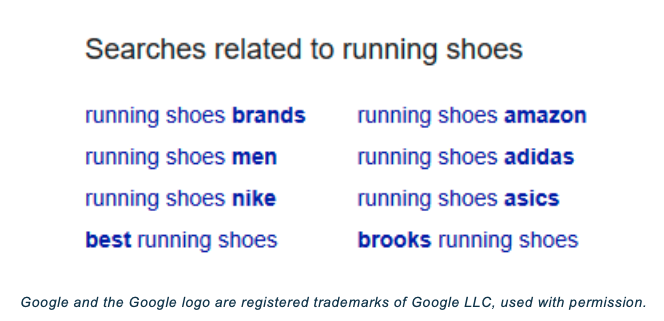It’s tempting to go after broad, high-volume keywords with huge audiences (and equally huge competition). But there’s an equally large — albeit more distributed audience — to be reached by targeting lower-competition, long tail keywords.
Imagine comets flying through the SEO solar system, if the most popular keywords make up the head of the comets (‘running shoes’, for example), each comet is trailed by a tail of more specific keywords like ‘long distance trail running shoes 2018’ and ‘best running shoes for flat feet’, that are useful in niche marketing.
Strategically pursuing the right long tail keywords as part of your SEO strategy can deliver several advantages.
As they have lower search volumes, they are usually much less competitive, making it easier for your brand to rank highly in search engine results.
Also, the specificity of long tail keywords generally indicates that those web searchers are nearer to the action part of their customers’ journeys. As a result, these keywords tend to have higher conversion rates.
Therefore, long tail keywords offer the opportunity to be discovered by your target audience when they are near their crucial decision points.
If you deeply understand and satisfy their specific search intent by providing compelling information or offers, even large competitors might not stand in your way.
But knowing that you need a long tail SEO strategy is only half the battle won, you need to find those keywords which are not always obvious.
Here are eight simple techniques that will help you target and find long tail keywords that align with your business’ goals:
1. Let Google autofill suggest long tail keywords for you
This is as simple as it seems, type a broad search term into the Google search bar and you’ll see a list of long tail keywords tuned to fit popular searches by users.

For further suggestions, you can then enter these phrases (or variations that they inspire) and view more long tail keywords to target with your SEO campaigns. For example, inputting ‘running shoes for women’ will generate a fresh list of Google auto-filled suggestions based around that (longer) keyword that get even longer tail still.
2. Leverage Google’s related searches
Similar to autofill, another completely free technique that leverages Google’s search engine is to look at Google’s related searches. Simply type any keyword and scroll to the bottom of the search results page to view useful long tail keyword suggestions.

3. Take suggestions from Ubersuggest
Ubersuggest is a tool you can use to find long tail keywords. Simply enter a term to receive a list of top suggestions.

4. Generate suggestions with the LSIGraph keyword generator
While the LSIGraph keyword generator helps you discover latent semantic indexing (LSI) keywords for semantic SEO, most LSI keywords can double as long tail keywords once you know how to recognize them.

5. Find long tail keywords in question forms with Answer The Public
Answer The Public aggregates results from Google and Bing to provide the most commonly searched questions related to a given term, and in a rather compelling visual format. Because valuable long tail keywords often happen to be in the form of a question, your SEO can benefit by utilizing these targets and providing content that directly answers questions pertaining to your brand.

6. Search for relevant users’ questions on Quora
Another way to source long tail keywords in question formats is to take a look at what people are asking on Quora. For example, searching for the topic ‘running shoes’ will show questions that might be smart to target as long tail keywords (and answer with your content).

7. Check out user discussions in online forums
Forums can also prove informative by offering yet another window into the questions and interests that potential customers are focused on. You can leverage these more specific topics as long tail keywords, and choose those that spark the most active conversations. To locate forums that cover a particular topic, search for ‘[your broad search term] + forum’.

8. Use a Keyword Difficulty Tool
Inputting a targeted generic term into a Keyword Difficulty tool can yield numerous related-keyword opportunities, many of which will be long tail options.
Tools tracking keyword difficulty usually also provide useful metrics to help you decide which long tail keywords make the most sense to target.
These include relevance to the original keyword, the popularity of the search term, the level of competition you’ll need to overcome in order to rank for your new long tail terms, and whether that keyword competition is within your site’s competitive power.

How to turn long tail keywords into SEO success?
Once you have a solid list of long tail keywords that are appropriate candidates to consider centering (or expanding) your SEO efforts around, you’ll need to vet them with research to ensure they possess the potential to deliver value. Ultimately, they must meet the two criteria that you need to keep top of mind:
- Competition on the keywords must be low enough that you have a good chance to compete and succeed.
- They must be popular and searched for frequently enough to be worth your time.
Once you’re sure the long tail keywords you’ve selected are the right ones, follow SEO best practices to include the targeted terms in your content, and help maximize the likelihood for each page to rank in search engine results for the respective terms.
SEO best practices include using the long tail keyword across the following page locations:
- The post title and meta title
- The page’s SEO meta description
- The first paragraph of the content
- Naturally throughout the content (Aim for a keyword density of around two percent)
- In at least one subheading
- Near the end of the content
- As an image alt tag for one image on the page
It’s also a best practice to use three or four LSI keywords related to the long tail keyword within your content and to create links on other pages within your site that point to each new content page.
With generic search terms ever-more-competitive and less apt for driving targeted traffic, it’s wise to pursue a diversified strategy that also utilizes long tail keywords, offering focused content to reach an audience that knows more about what it wants and is ready to be converted into customers.
Kim Kosaka is the Director of Marketing at Alexa.com.
The post Eight shortcuts to find long tail keywords (and how to use them) appeared first on Search Engine Watch.
from SEO – Search Engine Watch https://ift.tt/2TeykvN
via IFTTT

No comments:
Post a Comment